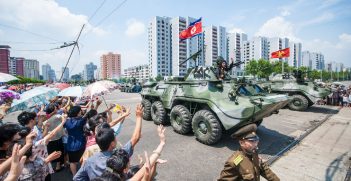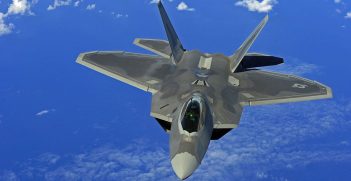Korean Nuclear Standoff: Lessons From Cuba

The long-running, high-stakes nuclear standoff between the US and North Korea is at risk of boiling over as the two countries’ leaders trade insults. With a tangible threat of war, what lessons can be learned from history?
During the Cold War there was a nuclear arms race between the two superpowers, the USSR and the United States, but the US strategy during the Cuban Missile Crisis employed a ‘flexible response’ that initially relied upon conventional weapons, even though the crisis concerned the deployment of nuclear weapons. Since the Korean War of 1950-53 there has been a political and military standoff between two Koreas, but the current tensions between North Korea and US, which inevitably also involve South Korea, have exposed some disturbing questions which have no obvious answers.
For example, if North Korea breaks the Armistice Agreement by attacking a US territory with a nuclear-armed intercontinental ballistic missile (ICBM), is this an act of war by North Korea upon the US, or is it also a military confrontation involving South Korea as a US ally against North Korea? Should a response be made with conventional or nuclear weapons?
Since any kind of response by the US is expected to result in a massive conventional attack by North Korean forces directed against the ROK-US Combined Forces Command, South Korea would surely suffer appalling casualties, so are such questions therefore moot? Would the Chinese still be prepared to explicitly support their old ally, North Korea? And what would the Japanese response be?
Kim Jong-un’s North Korean regime has relentlessly escalated the tensions on the Korean Peninsula. Repeated nuclear and missile tests, including the launch of a Hwasong-15 ICBM on 28 November—which is apparently capable of targeting the entire continental US—has prompted unprecedented rhetorical threats from US politicians. Supposed ‘surgical strikes’ are much discussed, but any military initiative by the US targeting North Korean nuclear and missile facilities would be severely hampered by the country’s mountainous terrain. In any case, this kind of action must be considered as a last resort given the unconscionable scale of the casualties that South Korea and US Forces Korea (USFK) would inevitably experience. A much more plausible strategy to deal with the current intractable situation is for the US to impose a maritime interdiction or blockade against North Korean vessels.
In this respect, the Cuban Missile Crisis surely provides some useful lessons: a flexible response with conventional military resources can prevail against nuclear blackmail. It is surely not a forlorn hope that a flexible response including a naval blockade might deter North Korean adventurism and ultimately persuade North Korea to back down.
Unconfirmed reports have been published by major US and South Korean media suggesting that the military authorities in the US and also in China have been investigating what kinds of practical lessons can be learned from the successful execution of the Cuban naval blockade (in fact, it was described as it a “naval quarantine” rather than a “naval blockade”, because the latter term is interpreted as an act of war under international law).
The Cuban Missile Crisis began when US intelligence aircraft detected the deployment to Cuba of USSR medium-range ballistic missiles. These carried nuclear warheads, and were capable of hitting targets as far away as Washington, DC, St Louis, and the Panama Canal. In response, for several weeks in October and November 1962, the US Navy imposed a blockade against Soviet vessels bound for Cuba. As a consequence, Soviet ships approaching Cuba turned back towards Russia, showing that Khrushchev had backed down, and the missiles which had already reached Cuba were ultimately removed, ending the crisis.
Although the risks arising from the Russian-American nuclear arms race are similar to those we are currently facing on the Korean Peninsula, the situation differs. There was a balance of power between the two superpowers of the Cold War era, whereas the US clearly has an overwhelming advantage, both conventional and nuclear, over North Korea. Despite this, propaganda seems to have convinced ordinary North Koreans that they could prevail. The question which all the countries involved need to answer—the US, China, and maybe South Korea—is how to adapt the lessons of the naval blockade of Cuba in 1962 to the current tensions.
Could a US-led multilateral naval blockade and/or interdiction operations be an effective strategy to bring North Korea to the negotiating table? Very likely. Will Kim Jong-un abandon his nuclear arsenal? Probably not, but he might be persuaded to take a less threatening posture toward the US and South Korea. Another important question is how such a blockade or interdiction targeting North Korean-registered commercial vessels in the open seas around the Korean Peninsula can be imposed without provoking North Korea to the point where war breaks out. It would be helpful if the US would stop using the same kind of inflammatory rhetoric that has always been standard from North Korea.
The only alternative to a naval blockade is a direct military attack on North Korea. This is widely considered to be extremely risky, and could perhaps even trigger a global nuclear conflict: it is tantamount to declaring World War 3. Contrast this with the single casualty of the Cuban Naval Blockade, the pilot of a U-2 spy plane which was shot down by a Russian SAM missile.
From a South Korean perspective, the fear is that any military conflict on the Korean Peninsula, even if it begins with conventional weapons, would ineluctably turn nuclear. Moreover, there is a growing feeling in the South Korea military that conventional weapons are no longer sufficient to deter North Korean military provocations and therefore the political-military status quo can only be maintained by South Korea acquiring its own nuclear arms.
It is absolutely crucial that no parties affected by the current nuclear and missile escalation on the Korean Peninsula are so irresponsible as to take unilateral military action. Apart from the dangers already described, this would violate the Armistice Agreement as well as various UN Security Council resolutions and neither the US congress nor the US president should consider such illegal steps. South Korean lives are just as valuable as American lives, and South Korea must be on board with any US-led multilateral naval interdiction or blockade. Prior consultations are essential within the ROK-US Combined Forces Command structure, and planning must take account of the huge civilian casualties that any US misstep could inflict.
Since the alternatives are so terrible, the historical lessons of the Cuban Missile Crisis should be scrutinised closely for any relevant applicability in resolving the current international crisis on the Korean Peninsula. Before the US takes any reckless military action against North Korea, every other strategic option must be exhausted. The use of limited coercion with conventional weapons, as in the imposition of a naval blockade, is a viable approach which should be explored.
If the US feels threatened by the prospect of massive casualties from a North Korean attack, they should bear in mind that millions of South Koreans have been living with this possibility, on a daily basis, for many decades. Securing the delicate equilibrium of regional peace requires a more nuanced and comprehensive strategy than this US administration has so far demonstrated.
Dr Sukjoon Yoon is a senior research fellow at the Korea Institute for Military Affairs and is a retired Republic of Korea (ROK) Navy Captain.
This article is published under a Creative Commons Licence and may be republished with attribution.





